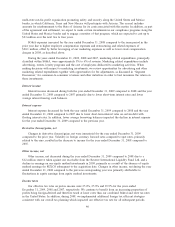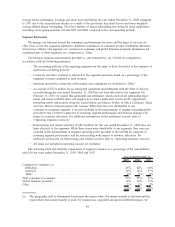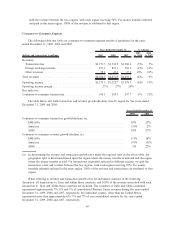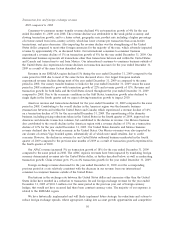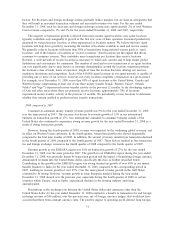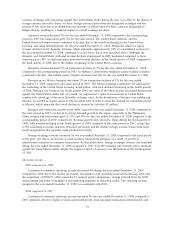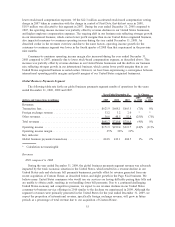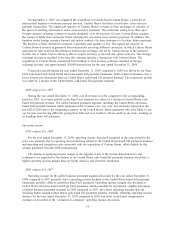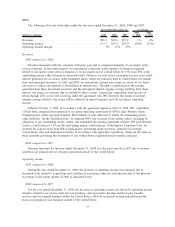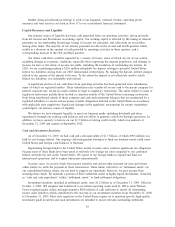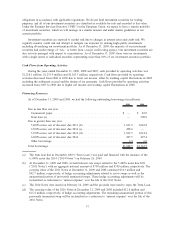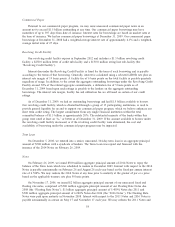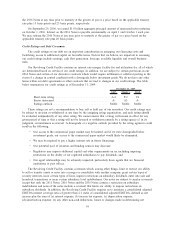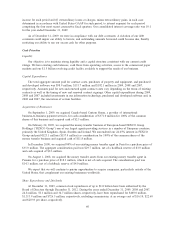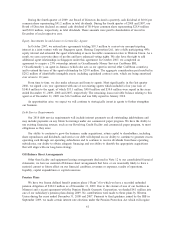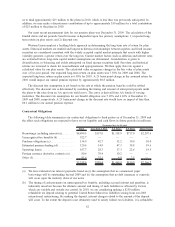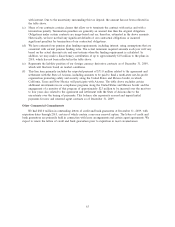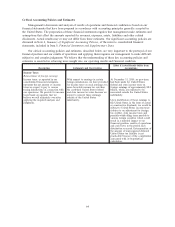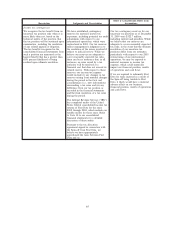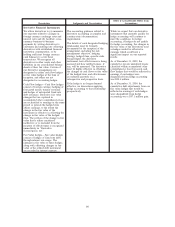Western Union 2009 Annual Report Download - page 70
Download and view the complete annual report
Please find page 70 of the 2009 Western Union annual report below. You can navigate through the pages in the report by either clicking on the pages listed below, or by using the keyword search tool below to find specific information within the annual report.Further financial information relating to each of our segments’ external revenue, operating profit
measures and total assets is set forth in Note 17 to our consolidated financial statements.
Capital Resources and Liquidity
Our primary source of liquidity has been cash generated from our operating activities, driven primarily
from net income and fluctuations in working capital. Our working capital is affected by the timing of interest
payments on our outstanding borrowings, timing of income tax payments, and collections on receivables,
among other items. The majority of our interest payments are due in the second and fourth quarters which
results in a decrease in the amount of cash provided by operating activities in those quarters, and a
corresponding increase to the first and third quarters.
Our future cash flows could be impacted by a variety of factors, some of which are out of our control,
including changes in economic conditions, especially those impacting the migrant population, and changes in
income tax laws or the status of income tax audits, including the resolution of outstanding tax matters. In
2010, we are considering making a $250 million refundable tax deposit relating to potential United States
federal tax liabilities arising from our 2003 international restructuring. By making the deposit, interest charges
related to the amount of the deposit will cease. To the extent the deposit is not ultimately used to satisfy
federal tax liabilities, it is refundable with interest.
A significant portion of our cash flows from operating activities has been generated from subsidiaries,
some of which are regulated entities. These subsidiaries may transfer all excess cash to the parent company for
general corporate use, except for assets subject to legal or regulatory restrictions. The assets subject to legal or
regulatory restrictions include those located in countries outside of the United States containing restrictions
from being transferred outside of those countries and cash and investment balances that are maintained by a
regulated subsidiary to secure certain money transfer obligations initiated in the United States in accordance
with applicable state regulations. Significant changes in the regulatory environment for money transmitters
could impact our primary source of liquidity.
We believe we have adequate liquidity to meet our business needs, including dividends and share
repurchases, through our existing cash balances and our ability to generate cash flows through operations. In
addition, we have capacity to borrow on our $1.5 billion revolving credit facility which was undrawn at
December 31, 2009 and expires in September 2012.
Cash and Investment Securities
As of December 31, 2009, we had cash and cash equivalents of $1.7 billion, of which $906 million was
held by our foreign entities. Our ongoing cash management strategies to fund our business needs could cause
United States and foreign cash balances to fluctuate.
Repatriating foreign funds to the United States would, in many cases, result in significant tax obligations
because most of these funds have been taxed at relatively low foreign tax rates compared to our combined
federal and state tax rate in the United States. We expect to use foreign funds to expand and fund our
international operations and to acquire businesses internationally.
In many cases, we receive funds from money transfers and certain other payment services and money
orders before we settle the payment of those transactions. These funds, referred to as “settlement assets” on
our consolidated balance sheets, are not used to support our operations. However, we earn income from
investing these funds. We maintain a portion of these settlement assets in highly liquid investments, classified
as “cash and cash equivalents” within “settlement assets,” to fund settlement obligations.
Investment securities, included in settlement assets, were $1.2 billion as of December 31, 2009. Effective
October 1, 2009, IPS assigned and transferred to us certain operating assets used by IPS to issue Western
Union branded money orders and approximately $860 million of cash sufficient to satisfy all outstanding
money order liabilities which contributed to the increase in our investment securities from December 31, 2008
to December 31, 2009. Most state regulators in the United States require us to maintain specific high-quality,
investment grade securities and such investments are intended to secure relevant outstanding settlement
56


